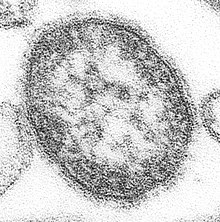Measles morbillivirus
| Measles morbillivirus | |
|---|---|

| |
| Measles morbillivirus electron micrograph
| |
| Virus classification | |
| (unranked): | Virus |
| Realm: | Riboviria |
| Kingdom: | Orthornavirae |
| Phylum: | Negarnaviricota
|
| Class: | Monjiviricetes |
| Order: | Mononegavirales |
| Family: | Paramyxoviridae |
| Genus: | Morbillivirus |
| Species: | Measles morbillivirus
|
| Synonyms[1] | |
|
Measles virus | |
Measles morbillivirus (MeV), also called measles virus (MV), is a
Disease
The virus causes
Replication cycle


Entry
The measles virus has two envelope
Genome replication and viral assembly
Once the virus has entered a host cell, its strand of negative sense ssRNA is used as a template to create a positive sense copy using the RNA-dependent RNA polymerase that's included in the virion. Then this copy is used to create a new negative copy, and so on, to create many copies of the ssRNA. The positive sense ssRNA is then mass translated by host ribosomes, producing all viral proteins. The viruses are then assembled from their proteins and negative sense ssRNA, and the cell will lyse, discharging the new viral particles and restarting the cycle.[10]


Genome and virion structure
The RNA genome of the virus codes 6 main proteins Nucleoprotein (N), Phosphoprotein (P), Matrix protein (M), Fusion protein (F), Hemagglutinin (H), and Large Protein (L),[11] which represents RNA dependent RNA polymerase (RdRp). The viral genome also codes two non-structural proteins C and V. These non-structural proteins are innate immunity antagonists; they help the virus to escape host immune response. Inside the virion genomic RNA is forming complex with N, L and P proteins. N, P and M proteins regulate RNA synthesis by RdRp. The virus is enveloped by a lipid membrane and glycoproteins H and F are virion surface proteins that are associated with this lipid membrane.[citation needed]

Evolution
The measles virus evolved from the now eradicated rinderpest virus which infected cattle.[12] Sequence analysis has suggested that the two viruses most probably diverged in the 11th and 12th centuries, though the periods as early as the 5th century fall within the 95% confidence interval of these calculations.[12]
Other analysis has suggested that the divergence may be even older because of the technique's tendency to underestimate ages when strong
Genotypes
The measles virus genome is typically 15,894 nucleotides long and encodes eight proteins.
Despite the variety of measles genotypes, there is only one measles serotype. Antibodies to measles bind to the hemagglutinin protein. Thus, antibodies against one genotype (such as the vaccine strain) protect against all other genotypes.[17]
The major genotypes differ between countries and the status of measles circulation within that country or region. Endemic transmission of measles virus was interrupted in the United States and Australia by 2000 and the Americas by 2002.[18]
Infection
In the early stages of infection, the measles virus via
References
- ^ "ICTV Taxonomy history: Measles morbillivirus". International Committee on Taxonomy of Viruses (ICTV). Retrieved 15 January 2019.
- ^ CDC (5 November 2020). "Measles is Easily Transmitted". Centers for Disease Control and Prevention. Retrieved 28 December 2023.
- PMID 23631113.
- S2CID 4409405.
- S2CID 30651799.
- )
- PMID 22721863.
- PMID 12029158.
- PMID 27657109.
- PMID 27854326.
- ^ ISBN 978-0-7817-6060-7.
- ^ PMID 20202190.
- PMID 21705379.
- ISBN 978-0-385-11256-7.
- PMID 18217182.
- PMID 29599155.
- ^ "Measles". Biologicals — Vaccine Standardization. World Health Organization. 11 March 2013. Archived from the original on 1 May 2014.
- ^ "No endemic transmission of measles in the Americas since 2002". Pan American Health Organization. 14 February 2017. Retrieved 11 September 2017.
- PMID 20042501.
- PMID 18568079.
- PMID 29743202.
- PMID 29437964.
- PMID 22761368.
- PMID 23365435.
- PMID 27194761.
External links
- "Measles virus". International Committee on Taxonomy of Viruses.
